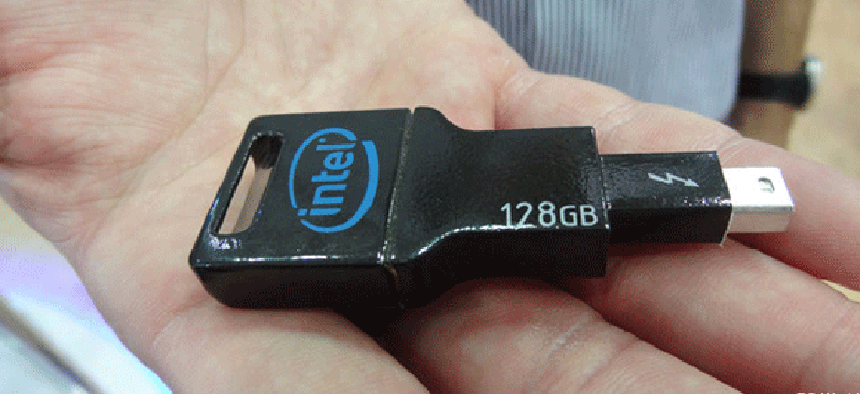Intel flashes 10-gigabit prototype Thunderbolt thumb drive

The Thunderbolt technology used in the thumb drive can transfer data at a speed of 10 gigabits/sec, which is about twice as fast as the current USB 3.0 transfer.
At the Computex show in Taipei last week, Intel showed a prototype version of a Thunderbolt key drive that boasts bi-directional transfer speeds of 10 gigabits/sec, making it the “world’s fastest thumb drive,” according to an article from the IDG News Service. The device connects directly to a Thunderbolt port and supports both data and video transmission through a single connection, making it attractive to agencies working with video or large data sets.
The prototype Thunderbolt thumb drive — whose speed is twice as fast as current USB 3.0 transfers — does not require cables, as do other Thunderbolt connections, and uses SanDisk SSD for storage, according to IDG News. Oren Huber, a Thunderbolt engineer, told IDG the prototype is a reference design and said there has been some interest in building products based on the design.
The Thunderbolt connects to high-performance peripherals such as graphics adapters, video and audio editors and storage devices, and it combines bi-directional data and video I/O performance. Apple added Thunderbolt connectors to Macs in 2011, and some PCs and peripherals have them. It allows users to transfer an entire HD movie in less than 30 seconds, making it ideal for fast synchronization of content between devices. For high performance back-up and restore, Thunderbolt can transfer of 1T of data in less than 5 minutes, the company said.
Initially available for Apple devices, there are now more than 80 Thunderbolt-enabled peripheral devices, according to Intel, covering everything from storage drives, expansion docks, displays and a variety of media capture and creation hardware. More than 220 companies worldwide are developing Thunderbolt-enabled products, the company added.
In a related development, Intel announced Thunderbolt 2, which enables 4K video file transfer and display simultaneously by combining the two previously independent 10 gigabits/sec channels into one 20 gigabits/sec bi-directional channel that supports data and/or display. Besides the benefits to those working with massive amounts of data such as video, it will allow terabytes of data to be backed up in a question of minutes, rather than hours. Thunderbolt 2 is currently slated to begin production before the end of this year.
NEXT STORY: The switch to IPv6 is on: Who’s out in front?






